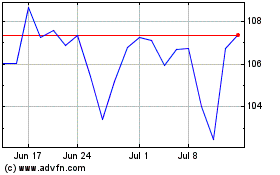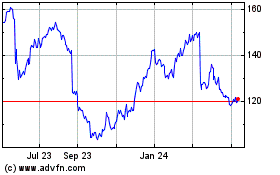Dollar Tree Swings to a Loss -- Update
September 01 2015 - 2:43PM
Dow Jones News
By Lisa Beilfuss
Dollar Tree Inc. swung to a loss in its latest quarter as the
discount retailer integrates its recently acquired rival.
The Virginia-based chain, which in July completed its $9 billion
acquisition of Family Dollar Inc., now operates nearly 14,000
stores across the U.S. and Canada.
Adjusted profit rose and sales benefited from the addition of
new stores, but the 48% revenue increase fell short of analysts'
expectations. Shares in the company fell 8% in afternoon trading,
erasing much of their year-to-date gain.
Dollar stores like Dollar Tree have poached market share from
bigger rivals such as Wal-Mart Stores Inc. by offering
less-expensive, everyday products and by scattering more
small-footprint stores in locations that make it easy for shoppers
to run errands quickly.
And in the second quarter, Dollar Tree again outperformed
Wal-Mart: Sales at stores open at least a year rose 2.7% compared
with a 1.5% increase at Wal-Mart. However, the sales, which exclude
the newly acquired Family Dollar stores, fell short of the 3.3%
increase analysts anticipated and were a bit shy of the 2.8% gain
competitor Dollar General Corp. reported last week. Adjusted for
swings in the Canadian dollar, same-store sales grew 2.4% in the
latest period. The gain came amid increased traffic and a higher
average ticket.
Chief Executive Bob Sasser said Dollar Tree has "quickly
initiated our integration plan" and the company is on track to
deliver $300 million in annual run-rate synergies by the end of the
third year after the acquisition.
The synergy piece, Chief Financial Officer Kevin Wampler said on
a call with analysts, "is going to be a bit of a marathon not a
sprint."
According to Cantor Fitzgerald analyst Laura Champine,
"management's synergy estimates appear very conservative," and
don't include operational improvements expected as Family Dollar
stores "benefit from Dollar Tree's strong management and superior
merchandising team."
Still, Ms. Champine is looking for a gross margin of 32.9% this
year, up from the 28.4% the company reported for the second quarter
but below the 34.2% a year ago. Some of the difference is
structural--Family Dollar margins were lower and the product mix is
different--and long-term gross margin for the combined company is
seen as below stand-alone Dollar Tree's gross margin, Ms. Champine
said.
As a result of the acquisition and integration, Dollar Tree said
it would refrain from providing earnings guidance for the current
quarter and pulled its per-share profit guidance for the full year.
Previously, the company said it expected to earn an adjusted $3.32
to $3.47 this year.
As part of the regulatory clearance for the merger, Dollar Tree
is required to sell 330 Family Dollar stores. Mr. Wampler said
those stores represent about $45.5 million in annual operating
income. In addition to losing that income, the CFO said the company
also expects to incur $5 million to $10 million in related
expenses.
For the business year ending in January, the retailer expects to
report revenue of $15.3 billion to $15.52 billion, based on a low
single-digit increase in same-store sales and short of the $15.57
billion analysts predicted.
Overall, Dollar Tree reported a loss of $98 million, or 46 cents
a share, down from a profit of $121.5 million, or 59 cents, a year
earlier. Excluding merger-related costs, among other items,
per-share profit fell to 25 cents from 61 cents. In the Dollar Tree
segment--reflecting stand-alone, premerger results--earnings per
share rose to 67 cents from 61 cents.
Revenue rose 48% to $3.01 billion. Family Dollar contributed
$811.6 million.
The company had guided for adjusted earnings per share of 63
cents to 68 cents.
Analysts, according to Thomson Reuters, predicted revenue of
$3.04 billion.
Write to Lisa Beilfuss at lisa.beilfuss@wsj.com
Subscribe to WSJ: http://online.wsj.com?mod=djnwires
(END) Dow Jones Newswires
September 01, 2015 14:28 ET (18:28 GMT)
Copyright (c) 2015 Dow Jones & Company, Inc.
Dollar Tree (NASDAQ:DLTR)
Historical Stock Chart
From Mar 2024 to Apr 2024

Dollar Tree (NASDAQ:DLTR)
Historical Stock Chart
From Apr 2023 to Apr 2024
